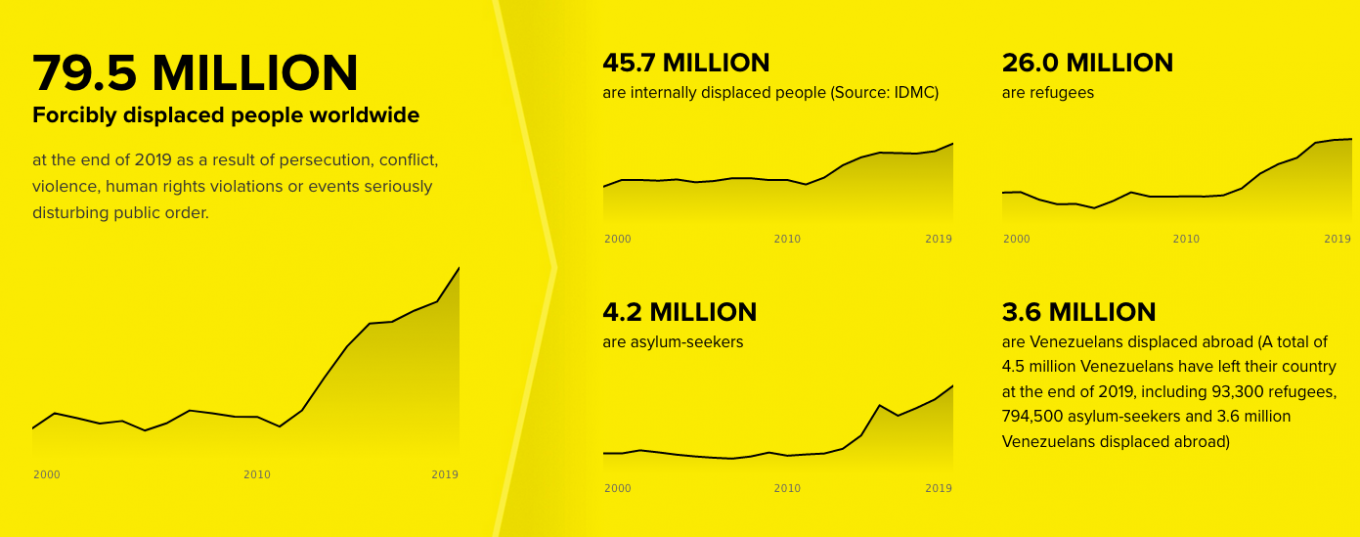For more than seven decades, UNHCR, in collaboration with States and partners, has been collecting data on refugees, stateless people and others who have been forced to flee.
As the UN Agency with a responsibility to protect and assist those who have been forced to flee, UNHCR has a vital role to play in generating and using information on forced displacement and statelessness. Such information can save lives, safeguard rights and well-being, and contribute to resilience and long-term solutions. In this context, UNHCR’s newly released Data Transformation Strategy 2020 – 2025 aims to position the organization as a trusted leader on data and information related to refugees and other affected populations.

One of UNHCR’s staple data products, supporting the aims of the Strategy, is the Global Trends report which is published every year in the week around World Refugee Day.
Global Trends analyzes the changes in forced displacement and statelessness and deepens public understanding of ongoing crises. This year the report reviews developments over the past decade and shows that an unprecedented 79.5 million were displaced as of the end of 2019. UNHCR has never seen a higher total. For more figures, you can read the latest report.
For UNHCR colleagues working with Statistics and Demographics, the period leading up to the release of Global Trends is the busiest of the year. This year even more so as the Report was accompanied by the launch of UNHCR’s new Refugee Population Statistics Database and complementary mobile application (available in the Play store and the App store).
In line with the Data Transformation Strategy, the new database enables humanitarian workers, decision-makers, researchers and many more to quickly access data and information on affected populations. The available information spans across almost 70 years of statistical activities and covers populations such as refugees, asylum-seekers, internally displaced as well as stateless individuals, most of who have never been displaced. The database also reflects the different types of solutions for displaced populations such as repatriation or resettlement.
The new database enables humanitarian workers, decision-makers, researchers and many more to quickly access data and information on affected populations.
Making refugee data readily available to a larger audience has many benefits. First of all, for decision-makers, researchers, media partners and many others, having information available at your fingertips can help to quickly inform discussions and provide empirical background data for decision-taking. Furthermore, the mobile application version is also available in an offline capability meaning that humanitarian staff and other interested will also be able to access the information in remote locations with poor connectivity, unfortunately a reality for many of UNHCR’s operations. Secondly, the database includes key indicators on UNHCR’s populations of concern, including their demographics. But the truly ground-breaking component of the database is the possibility to easily summarize how many forcibly displaced and stateless individuals there are within a specific country, or based on their country of origin, where they now find themselves in the world. Those are the “within” and “from” views in the database. Say you work for a small charity that specifically help Somali refugees; the database can help you locate which countries currently host Somali refugee populations. Say you now work for the France office of this small charity; you can use the database to find out how many Somali refugees and asylum-seekers specifically reside in France.
To find out more, please visit the Refugee Population Statistics Database. The mobile application can be downloaded from the Apple App Store and from Google Play.
The database is expected to become the go-to source for up-to-date figures on forced displacement. If you have any questions, have comments or would like to give feedback, please do not hesitate to contact us at: [email protected]
